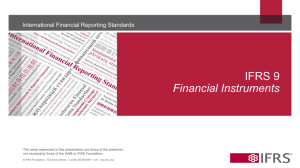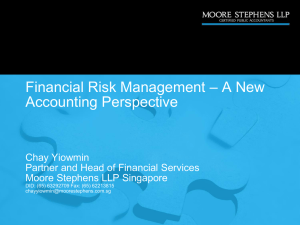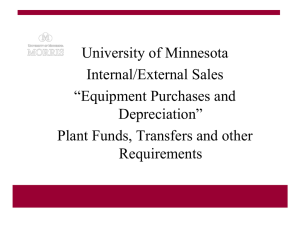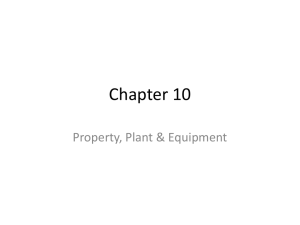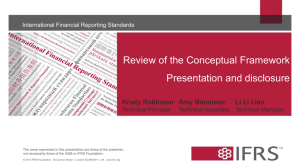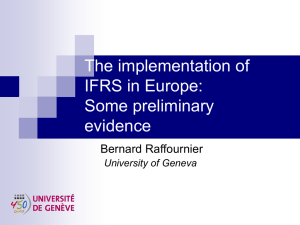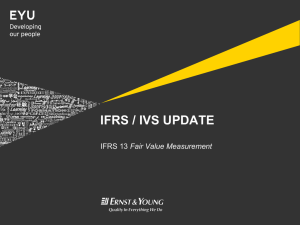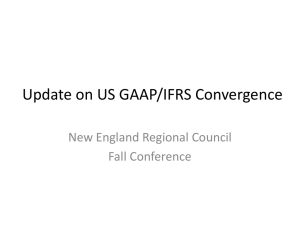IFRS-CGAAP Transitional PP&E Amounts
advertisement
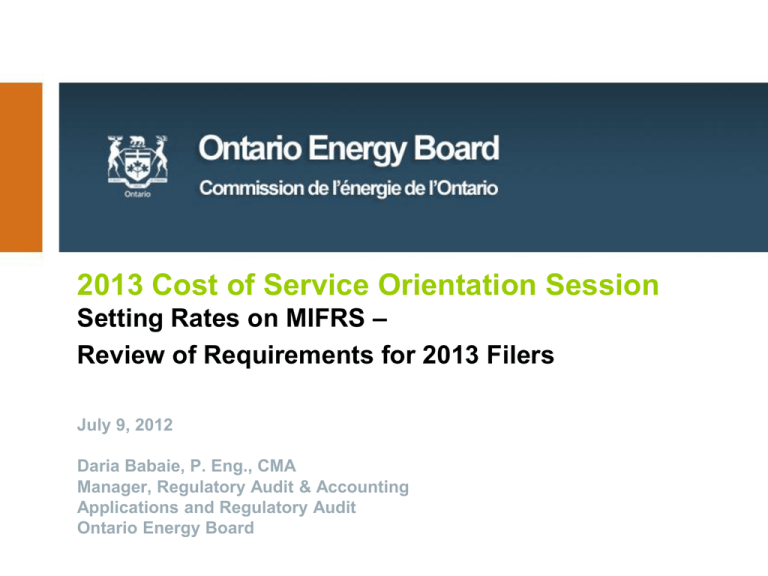
2013 Cost of Service Orientation Session Setting Rates on MIFRS – Review of Requirements for 2013 Filers July 9, 2012 Daria Babaie, P. Eng., CMA Manager, Regulatory Audit & Accounting Applications and Regulatory Audit Ontario Energy Board Agenda 1. Modified IFRS (“MIFRS”) 2. Direction from the OEB – 2013 Rates 3. 2013 Filing Requirements – MIFRS • MIFRS Appendices 4. Common Pitfalls from 2012 MIFRS Applications 5. Questions 2 What is Modified IFRS (“MIFRS”)? • Modified IFRS (“MIFRS”) – IFRS accounting as modified for regulatory purposes • Greater consistency in measurement of rate impacts – Capitalization practice – Calculation of depreciation expenses 3 Section 2.3.1 - Key References for Interpreting Filing Requirements for Modified IFRS • Report of the Board: Transition to IFRS, July 2009 – policy – • • • Key areas impacted • Electricity and gas distributors, implications for others • Regulatory accounting policies, application filing requirements, Reporting & Record-keeping Requirements Asset Depreciation Study for the Ontario Energy Board – Kinectrics July 8, 2010 Addendum to Report of the Board: Implementing IFRS in an IRM Environment June 13, 2011 April 30, 2012 Direction of the OEB 4 April 30, 2012 Direction of the OEB on Application Filing for the 2013 Rate Year • • All 2013 cost of service applications must be filed on the basis of MIFRS, for rateregulated utilities that have adopted IFRS or are required to adopt IFRS by January 1, 2013. Exception for those seeking the Board’s approval to adopt an alternate accounting standard such as US GAAP or Accounting Standards for Private Enterprise (“ASPE”). 5 Section 2.3.4 - MIFRS Application Filing for the 2013 Rate Year Format of Required Information Filing The Year Historical Bridge Applicant Year year Adopts IFRS (2011) (2012) for Financial Reporting 2012 CGAAP MIFRS MIFRS 2013 CGAAP CGAAP MIFRS Test Year (2013) MIFRS MIFRS 6 Section 2.3.4 - MIFRS Application Filing for the 2013 Rate Year • Provide a summary of changes to its accounting policies made since the last cost of service filing (e.g. capitalization of overhead, capitalization of interest, depreciation, etc.) – Revenue requirement impacts of any change in capitalization policy must be specifically and separately quantified. 7 Section 2.3.4 - MIFRS Application Filing for the 2013 Rate Year • Provide a summary of the dollar impacts of MIFRS to each component of the revenue requirement (e.g. rate base, operating costs, etc), including the overall impact on the proposed revenue requirement. – Identify financial differences and resulting revenue requirement impacts arising from the adoption of MIFRS accounting. 8 Section 2.5 – Rate Base: Gross Assets – Property, Plant, and Equipment (PP&E) and Accumulated Depreciation The Applicant Adopts IFRS in 2012 for Financial Reporting Appendix 2-B Property, Plant and Equipment • Establish the continuity of historic cost by using the December 31, 2010 regulatory gross assets of property, plant and equipment as the opening January 1, 2011 regulatory gross assets. – December 31, 2010 regulatory gross PPE by asset class. – January 1, 2011 regulatory gross PPE by asset class. Accumulated Depreciation • Establish the continuity of historic cost by using the December 31, 2010 regulatory accumulated depreciation as the opening January 1, 2011 accumulated depreciation. – December 31, 2010 regulatory accumulated depreciation by asset class. – January 1, 2011 regulatory accumulated depreciation by asset class. 9 Section 2.5 – Rate Base: Gross Assets – Property, Plant, and Equipment (PP&E) and Accumulated Depreciation The Applicant Adopts IFRS in 2013 for Financial Reporting Appendix 2-B Property, Plant and Equipment • Establish the continuity of historic cost by using the December 31, 2011 regulatory gross assets of property, plant and equipment as the opening January 1, 2012 regulatory gross assets. – – Accumulated Depreciation December 31, 2011 regulatory gross PPE by asset class. January 1, 2012 regulatory gross PPE by asset class. • Establish the continuity of historic cost by using the December 31, 2011 regulatory accumulated depreciation as the opening January 1, 2012 accumulated depreciation. – December 31, 2011 regulatory accumulated depreciation by asset class. – January 1, 2012 regulatory accumulated depreciation by asset class. 10 Section 2.5 – Rate Base: Gross Assets – Property, Plant, and Equipment (PP&E) Appendix 2-B: Fixed Asset Continuity Schedule Key Note: • Continuity statements should be reconcilable to the calculated depreciation expenses (Appendix 2-C) and presented by asset account. 11 Section 2.5.2: Capital Expenditures – Capitalization Policy • • • File capitalization policy, including changes to that policy since the last rebasing application Explain the reasons for the changes and whether they are as a result of adhering to the IFRS capitalization accounting requirements (e.g. capitalization of indirect costs, etc.) If adopting IFRS by January 1, 2013: Must adhere to IFRS capitalization accounting requirements for rate making and regulatory reporting purposes after the date of adoption of IFRS. 12 Section 2.5.2: Capital Expenditures – Capitalization of Overhead • Identify the burden rates related to the capitalization of costs of self-constructed assets. • If the burden rates were changed, identify the burden rates: – Prior to the change – After the change 13 Section 2.7.2: Operating Costs – Summary and Cost Driver Tables • • Identify the overall level of increase (or decrease) in OM&A expense in the test year in relation to a decrease (or increase) in capitalized overhead. Provide a variance analysis for the change in OM&A expense for the test year in respect to each of the bridge year and historical years. 14 Section 2.7.2: Operating Costs – Summary and Cost Driver Tables Appendix 2-D: Overhead Expense 15 Section 2.7.7: Depreciation/Amortization/Depletion • • Use the Board sponsored Kinectrics study or provide your own study to justify changes in useful lives. Provide a list detailing all asset service lives. – – • Detail differences of asset service lives from the Typical Useful Lives (TUL) from the Kinectrics Report A detailed explanation for using a service life that is different from the TUL in the Kinectrics Report. Perform a recalculation to determine the average remaining life of the opening balance of assets on the transition date to IFRS (i.e. excluding the transition year capital additions). 16 Section 2.7.7: Depreciation/Amortization/Depletion IFRS for financing reporting in 2012 Appendices 2-CA to 2-CD: Depreciation and Amortization Expense 17 Section 2.7.7: Depreciation/Amortization/Depletion IFRS for financing reporting in 2013 Appendices 2-CE to 2-CH: Depreciation and Amortization Expense 18 Section 2.12.4 Account 1575 – IFRSCGAAP Transitional PP&E Amounts • The IFRS-CGAAP Transitional PP&E Amount is to be cleared in rates as follows: – – an adjustment to the test year depreciation expense as part of distribution expenses for the amortization of Account 1575 an adjustment to the test year revenue requirement as part of the return on rate base component. The applicant must not record the return on rate base component in Account 1575 for accounting purposes. 19 Section 2.12.4 Account 1575 – IFRSCGAAP Transitional PP&E Amounts • • Consistent with the 4 year normal rate cycle, Appendices 2-EA and 2-EB are using a 4 year amortization period as a default disposition period to "clear" the PP&E deferral account No carrying charges will be applied to the balance in the applied to the balance in the PP&E account. 20 Section 2.12.4 Account 1575 – IFRSCGAAP Transitional PP&E Amounts • Propose a disposition period to “clear” the PP&E deferral account through a onetime adjustment to rate base to capture and remove the impact of the accounting policy changes as caused by the transition from CGAAP to MIFRS. – – The Board will determine the period of time for amortization on a case-by-case basis. The Board will be guided primarily by such considerations as the impact on rates, implications of any other IFRS transition matters, any requirements for rate mitigation including the impact on the distributor’s customers and its cash flow position, and other matters such as intergenerational equity. 21 Section 2.12.4 Account 1575 – IFRSCGAAP Transitional PP&E Amounts Key Notes: • • • The Fixed Asset Continuity Schedule (Appendix 2-B) in the rate application must not be adjusted for balances related to the IFRSCGAAP Transitional PP&E Amount. Provide a breakdown of the balance related to the IFRS-CGAAP Transitional PP&E Amount that is effective on the transition date to MIFRS. Provide the supporting analysis of the amounts in this account by completing Appendix 2-EA or 2-EB to the Filing Requirements. – The drivers of the change in closing net PP&E (CGAAP versus MIFRS) must be identified and quantified. 22 Section 2.12.4 Account 1575 – IFRSCGAAP Transitional PP&E Amounts IFRS for financing reporting in 2012 Appendix 2-EA: IFRS-CGAAP Transitional PP&E Amounts 23 Section 2.12.4 Account 1575 – IFRSCGAAP Transitional PP&E Amounts IFRS for financing reporting in 2013 Appendix 2-EB: IFRS-CGAAP Transitional PP&E Amounts 24 Section 2.12.3 One-Time Incremental IFRS Costs Provide a breakdown of the costs recorded in Account 1508 Other Regulatory Assets, Sub-account Deferred IFRS Transition Costs or Account 1508 Other Regulatory Assets, Sub-account IFRS Transition Costs Variance. 25 Section 2.12.3 One-Time Incremental IFRS Costs Appendix 2-U: One-Time Incremental IFRS Costs 26 Common Pitfalls from 2012 MIFRS Applications • Some CGAAP or MIFRS schedules for depreciation and PP&E were missing. • It was not clear whether the schedules were MIFRS schedules or CGAAP schedules. • Some applicants provided schedules for depreciation and PP&E that were not labelled properly • The closing of one year in the PP&E schedule was not equal to the opening balance in the next year. • It was not clear if average remaining service life of the asset was used for calculation of the depreciation on date of transition to IFRS. 27 Common Pitfalls from 2012 MIFRS Applications • Some applicants did not provide the transition year in both CGAAP and MIFRS, but rather went straight from CGAAP in 2011 to MIFRS in 2012 in the continuity schedules. – The rate base and the revenue requirement were adversely impacted. 28 Common Pitfalls from 2012 MIFRS Applications • Some applicants did not file a copy of their capitalization policies in the pre-filed evidence. • Some applicants stated that they did not have a capitalization policy when Board staff asked an interrogatory. 29 Common Pitfalls from 2012 MIFRS Applications • Multiple updates of MIFRS evidence occurred in some cases. • The MIFRS evidence also changed from one filing to another without an explanation by some applicants. • In some cases, there was insufficient or incomplete information filed to describe the net impact on the revenue requirement under MIFRS. 30 Common Pitfalls from 2012 MIFRS Applications – Deferral and Variance Accounts • Some applicants used different figures throughout its evidence related to the deferral and variance account balances. • Some applicants did not request a consistent disposition period for the deferral and variance accounts. – For example, one account had a disposition period of three years, whereas other accounts had a disposition period of two years. 31 32
